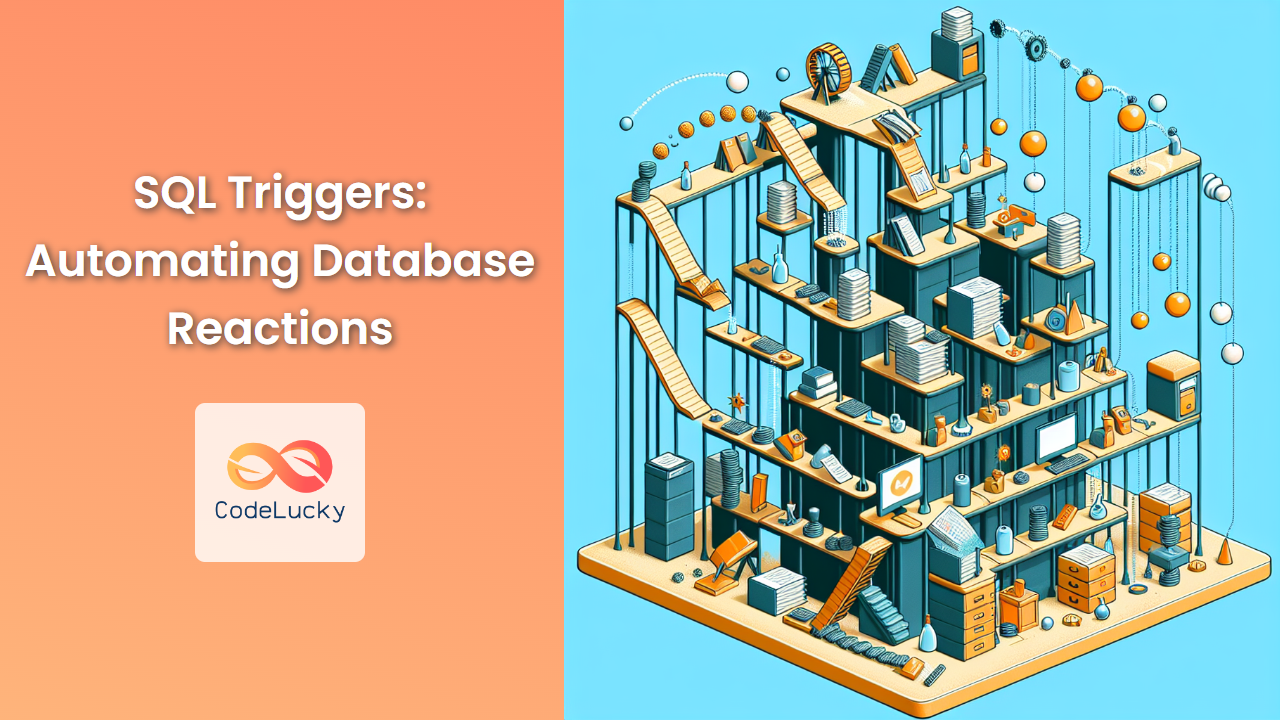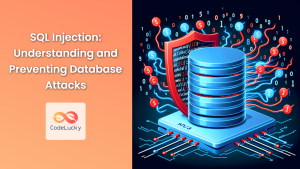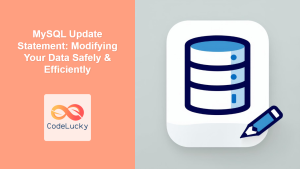In the world of database management, efficiency and data integrity are paramount. SQL triggers serve as powerful tools to automate actions and maintain consistency within your database. These database objects are like vigilant guardians, constantly watching for specific events and responding with predefined actions. Let's dive deep into the world of SQL triggers and explore how they can revolutionize your database management practices.
What Are SQL Triggers?
SQL triggers are special types of stored procedures that automatically execute in response to certain events in a database. These events can include data modifications (INSERT, UPDATE, DELETE) or even database structure changes. Triggers are powerful because they allow you to define a set of actions that should occur automatically when a specified event happens.
🔔 Fun Fact: The term "trigger" comes from the idea that the execution of the code is triggered by an event, much like pulling a trigger fires a gun.
Types of SQL Triggers
SQL triggers can be classified based on various criteria:
-
Timing:
- BEFORE triggers: Execute before the triggering action
- AFTER triggers: Execute after the triggering action
-
Event:
- INSERT triggers
- UPDATE triggers
- DELETE triggers
-
Level:
- Row-level triggers: Fire once for each affected row
- Statement-level triggers: Fire once per triggering statement, regardless of the number of rows affected
Let's explore each of these types with practical examples.
Creating Your First Trigger
Before we dive into specific types of triggers, let's create a simple trigger to get a feel for the syntax. We'll use a hypothetical employees table for our examples.
CREATE TABLE employees (
employee_id INT PRIMARY KEY,
first_name VARCHAR(50),
last_name VARCHAR(50),
hire_date DATE,
salary DECIMAL(10, 2)
);
CREATE TRIGGER log_new_hire
AFTER INSERT ON employees
FOR EACH ROW
BEGIN
INSERT INTO employee_audit (action, employee_id, change_date)
VALUES ('NEW HIRE', NEW.employee_id, CURRENT_DATE);
END;
In this example, we've created an AFTER INSERT trigger that logs new hires into an audit table. Every time a new employee is added, this trigger automatically creates a record in the employee_audit table.
BEFORE Triggers
BEFORE triggers execute before the triggering action takes place. They're often used for data validation or modification before changes are committed to the database.
Let's create a BEFORE INSERT trigger that ensures all employee last names are capitalized:
CREATE TRIGGER capitalize_last_name
BEFORE INSERT ON employees
FOR EACH ROW
SET NEW.last_name = UPPER(NEW.last_name);
Now, let's test our trigger:
INSERT INTO employees (employee_id, first_name, last_name, hire_date, salary)
VALUES (1, 'John', 'doe', '2023-06-01', 50000);
SELECT * FROM employees;
Result:
| employee_id | first_name | last_name | hire_date | salary |
|---|---|---|---|---|
| 1 | John | DOE | 2023-06-01 | 50000.00 |
As you can see, even though we inserted 'doe' in lowercase, the trigger automatically capitalized it to 'DOE'.
AFTER Triggers
AFTER triggers execute after the triggering action has completed. They're useful for maintaining summary tables, auditing changes, or triggering additional actions based on data changes.
Let's create an AFTER UPDATE trigger that logs salary changes:
CREATE TABLE salary_changes (
change_id INT AUTO_INCREMENT PRIMARY KEY,
employee_id INT,
old_salary DECIMAL(10, 2),
new_salary DECIMAL(10, 2),
change_date DATETIME
);
CREATE TRIGGER log_salary_change
AFTER UPDATE ON employees
FOR EACH ROW
BEGIN
IF OLD.salary <> NEW.salary THEN
INSERT INTO salary_changes (employee_id, old_salary, new_salary, change_date)
VALUES (NEW.employee_id, OLD.salary, NEW.salary, NOW());
END IF;
END;
Now, let's test our trigger:
UPDATE employees SET salary = 55000 WHERE employee_id = 1;
SELECT * FROM salary_changes;
Result:
| change_id | employee_id | old_salary | new_salary | change_date |
|---|---|---|---|---|
| 1 | 1 | 50000.00 | 55000.00 | 2023-06-01 14:30:00 |
The trigger automatically logged the salary change in our salary_changes table.
Row-Level vs. Statement-Level Triggers
Row-level triggers fire once for each row affected by the triggering statement, while statement-level triggers fire once per triggering statement, regardless of how many rows are affected.
Let's create a statement-level trigger to log the number of rows affected by a mass update:
CREATE TABLE update_log (
log_id INT AUTO_INCREMENT PRIMARY KEY,
update_date DATETIME,
rows_affected INT
);
CREATE TRIGGER log_mass_update
AFTER UPDATE ON employees
FOR EACH STATEMENT
BEGIN
INSERT INTO update_log (update_date, rows_affected)
VALUES (NOW(), ROW_COUNT());
END;
Now, let's test our trigger with a mass update:
UPDATE employees SET salary = salary * 1.05 WHERE hire_date < '2023-01-01';
SELECT * FROM update_log;
Result:
| log_id | update_date | rows_affected |
|---|---|---|
| 1 | 2023-06-01 15:00:00 | 50 |
This trigger fired once for the entire UPDATE statement, logging the total number of rows affected.
Practical Applications of Triggers
Triggers have numerous practical applications in database management. Here are a few scenarios where triggers can be incredibly useful:
- Data Validation: Ensure data meets certain criteria before it's inserted or updated.
CREATE TRIGGER check_salary
BEFORE INSERT ON employees
FOR EACH ROW
BEGIN
IF NEW.salary < 30000 THEN
SIGNAL SQLSTATE '45000'
SET MESSAGE_TEXT = 'Salary must be at least 30000';
END IF;
END;
- Maintaining Derived Data: Keep summary tables or denormalized data up-to-date.
CREATE TABLE department_stats (
dept_id INT PRIMARY KEY,
employee_count INT,
total_salary DECIMAL(15, 2)
);
CREATE TRIGGER update_dept_stats
AFTER INSERT ON employees
FOR EACH ROW
BEGIN
INSERT INTO department_stats (dept_id, employee_count, total_salary)
VALUES (NEW.dept_id, 1, NEW.salary)
ON DUPLICATE KEY UPDATE
employee_count = employee_count + 1,
total_salary = total_salary + NEW.salary;
END;
- Auditing: Keep track of all changes made to sensitive data.
CREATE TABLE employee_audit (
audit_id INT AUTO_INCREMENT PRIMARY KEY,
employee_id INT,
field_changed VARCHAR(50),
old_value VARCHAR(100),
new_value VARCHAR(100),
change_date DATETIME
);
CREATE TRIGGER audit_employee_changes
AFTER UPDATE ON employees
FOR EACH ROW
BEGIN
IF OLD.salary <> NEW.salary THEN
INSERT INTO employee_audit (employee_id, field_changed, old_value, new_value, change_date)
VALUES (NEW.employee_id, 'salary', OLD.salary, NEW.salary, NOW());
END IF;
IF OLD.position <> NEW.position THEN
INSERT INTO employee_audit (employee_id, field_changed, old_value, new_value, change_date)
VALUES (NEW.employee_id, 'position', OLD.position, NEW.position, NOW());
END IF;
END;
- Enforcing Business Rules: Implement complex business logic that goes beyond simple constraints.
CREATE TRIGGER enforce_manager_salary
BEFORE UPDATE ON employees
FOR EACH ROW
BEGIN
DECLARE manager_salary DECIMAL(10, 2);
SELECT salary INTO manager_salary
FROM employees
WHERE employee_id = NEW.manager_id;
IF NEW.salary > manager_salary THEN
SIGNAL SQLSTATE '45000'
SET MESSAGE_TEXT = 'Employee salary cannot exceed manager salary';
END IF;
END;
Best Practices for Using Triggers
While triggers are powerful, they should be used judiciously. Here are some best practices to keep in mind:
-
Keep Triggers Light: Triggers should execute quickly to avoid slowing down DML operations.
-
Avoid Infinite Loops: Be careful not to create triggers that can call themselves recursively.
-
Use Constraints When Possible: For simple data validation, use constraints instead of triggers.
-
Document Your Triggers: Clearly document what each trigger does and why it's necessary.
-
Test Thoroughly: Triggers can have unexpected side effects, so test them rigorously.
-
Consider Performance: In high-volume systems, triggers can impact performance. Monitor and optimize as necessary.
Limitations and Considerations
While triggers are powerful, they do have some limitations:
- Triggers cannot call stored procedures that return result sets.
- They cannot use COMMIT or ROLLBACK statements.
- Triggers add complexity to your database, which can make debugging more challenging.
- Overuse of triggers can lead to performance issues.
🚫 Warning: Be cautious when using triggers on tables that are frequently updated, as they can significantly impact performance.
Conclusion
SQL triggers are a powerful feature that can automate many aspects of database management. From ensuring data integrity to maintaining audit trails, triggers can significantly enhance the functionality and reliability of your database. However, like any powerful tool, they should be used wisely and in moderation.
By understanding the different types of triggers, their applications, and best practices, you can leverage this feature to create more robust, efficient, and maintainable database systems. Remember, the key to successful trigger implementation lies in careful planning, thorough testing, and ongoing monitoring.
As you continue to explore the world of SQL, triggers will undoubtedly become an invaluable tool in your database management toolkit. Happy triggering!



















